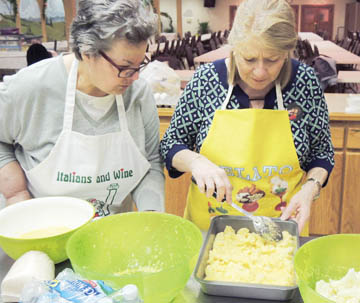
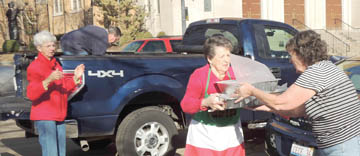
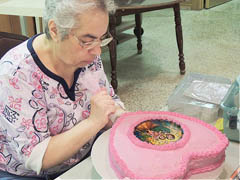
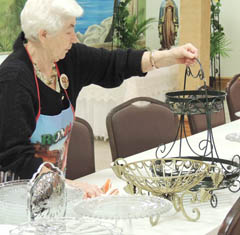
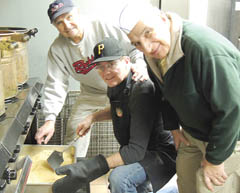
ROCKFORD—Visitors to the St. Joseph Altar held annually at St. Anthony of Padua Parish, here, witness prayers and blessings before enjoying a meal of pasta, eggs and pastries. This simple Lenten dinner, eaten in view of the ornately decorated altar honoring St. Joseph, only begins to tell the story of this long-running, faith-filled tradition.
The concept for the modern day St. Joseph Altar originated many centuries ago when the people of Sicily sought the intercessory prayers of St. Joseph to deliver them from a famine and drought. When their prayers were answered, the Sicilians held a great feast to honor St. Joseph.
Through the years, Italian families of St. Anthony Parish often hosted St. Joseph Altars at their homes in thanksgiving for answered prayers. The St. Joseph Altar became a yearly parish event in the 1960s.
“Over the years, there has been a great devotion to St. Joseph in our parish, especially during the world wars,” said Joan Gullo, co-chair of this year’s altar. “In the 1940s, Italian Catholics in Rockford would erect home altars, even several on one block, where people would pray for their loved ones in the service or for someone who had been injured in the war,” she said.
The religious traditions of the altar include a nine-day novena that is prayed leading up to the event, prayers sung in Italian, a rosary and litany in honor of St. Joseph, the altar blessing on Saturday night and prayers before the meal on Sunday.
“We have always had three parishioners seated at a special table by the altar to represent the Holy Family — Mary, Joseph and Jesus,” said Colleen Gullo, co-chair. “This year, the Holy Family will be represented by children of the parish.”
The three levels of the St. Joseph Altar pay tribute to the Holy Trinity and many of the baked goods on the altar are shaped in Catholic symbols.
According to Joan, planning for the event begins several months prior to the March date.
“We start thinking about next year’s St. Joseph Altar practically the day after we finish our current year’s altar,” she said. “I would say that our ‘baking phase,’ getting the Italian cookies ready for the altar, runs from the end of February until the week of the altar.”
The homemade cookies include cuchidati, fig-filled cookies that are often intricately shaped into different Catholic images; chocolate spiced anise cookies; biscotti, almond or anise flavored sliced cookies; sesame cookies; and white frosted cookies.
Preparing pignolati — pyramid shaped pastry kernels caramelized with sugar and honey — is long and involved.
“Making the pignolati is a two-day process,” Joan said. “We have to roll the pieces of dough, fry them and let them set up. We have a big crew that puts the pignolati together, they melt the sugar and honey to caramelize the dough. It’s a very intimidating process.”
Bringing families together to continue the culinary and religious traditions of the St. Joseph Altar is another important aspect of the event.
“In making the foods for this year’s altar, we had at least 18 people standing around the island in our church kitchen. Our youngest volunteers were in their 60s and we even had two ladies in their 90s who came out to help us,” Joan said.
Since the St. Joseph Altar is celebrated during Lent, the main dish served is pasta con sarde, spaghetti with a red sauce flavored with fish.
The pasta is topped with modica, a bread crumb mixture which is said to symbolize sawdust from St. Joseph’s workshop.
Slices of frosia, an egg dish with vegetables, are served with the pasta as a source of protein.
“We do have wonderful, generous people from our parish and the Rockford community who donate cookies, cakes and frosias for us to serve at the altar,” Joan said. She estimates that around 200 pounds of flour is used to make about 6000 Italian cookies at the church.
Additionally, between 900 and 1,400 meals are served at the altar which include meals that are taken to the homebound.
Louis Miceli heads up the kitchen crew on Saturday and Sunday making around 85 gallons of sauce and cooking about 252 pounds of pasta.
St. Joseph Altar meals are also delivered to the Poor Clare nuns on South Main Street and any left-over food is donated to the Rockford Rescue Mission for the homeless.
Joan credits many prayers for the ongoing success of St. Anthony Parish’s St. Joseph Altar. She and her volunteers see this event as a way to teach others about a unique aspect of Italian heritage, religious devotion to St. Joseph and of course, excellent food. “We have beautiful, wonderful workers who all come together to work on a common project. Being a part of the St. Joseph Altar really transforms people and as hard as the work is, and as tired as everybody gets, this experience is very satisfying.”














